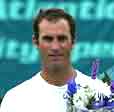Paul Goldstein
(1976 - )

After achieving the highest singles ranking of his career in August, 2000 (No. 69), Goldstein is currently ranked No. 143 (as of July 8, 2004); he is also ranked No. 223 in doubles play (his highest doubles ranking was No. 75 in November 2000). Goldstein, whose father Clark was a former table tennis champion, began playing tennis when he was nine years old. Described as "an all-court player with strong groundstrokes and excellent concentration," his first major victory came when he was ranked No. 1 in the USTA Boys' 16 age group in 1992. Later, while at Stanford University, Paul teamed with Scott Humphries to win numerous doubles championships. He also became the first athlete in college tennis history to play for four NCAA team tournament champions.
During Paul's senior year, he played No. 1 singles and led Stanford to a 28-0 regular season record. His coach at Stanford, Dick Gould, praised Goldstein, saying, "I have been blessed with outstanding young people in my 36 years of coaching at the collegiate level. However, I can think of only one or maybe two players for whom I could give as high a recommendation as Paul. And certainly no one would receive a higher endorsement from me than Paul."
Following a terrific college career, Goldstein turned pro in 1998 at the ATP tour event in Washington, D.C., which is near his home town of Rockville, Maryland. When he made it to the round of 16 at the same tournament a year later, Paul said it was his "biggest thrill as a professional tennis player to date." Goldstein then faced a near impossible challenge in the U.S. Open that year when he had to play Pete Sampras. He was able to stretch the match to 4 sets, but lost to the world's No. 1 ranked player.
Goldstein finished 1999 as the No. 90 ranked player in the world, the first time he was able to crack the top 100. That year, he won the gold medal at the Pan American Games. Paul consistently improved his ATP ranking, reaching No. 69 in 2000. That year, he reached the third round of Wimbledon for the second consecutive year (he participated in all 4 Grand Slam events in the same year for the first time in his career) and had a great second-round match with Jeff Tarango (3-6, 6-2, 5-7, 6-2, 12-10).
Goldstein was a practice partner for the first-round match against Zimbabwe in the 2000 Davis Cup. In 2001, he competed in the Australian Open, where he lost in the second round, and in the French Open, where he lost in the first round. Paul was defeated in the qualifying rounds at the 2001 U.S. Open. He competed in the 2002 Australian Open but lost in the qualifying rounds again. At the 2002 U.S. Open, Goldstein lost in the second round of qualifying to Danai Udomchoke (THA), 6-4, 6-1.
In the qualifying tournament for the 2003 Australian Open, Goldstein lost in the first round to Robert Kendrick of the United States. Paul also played in the qualifying tournament for Wimbledon and lost in the first round to Israeli, Harel Levy.
Goldstein's singles form reached it's pinnacle towards the end of 2003. He won the Austin tournament in mid November by beating Robert Kendrick (USA), 6-3 6-3 in the final. Later that month, he won the title in Champaign, Illinois.
Sources: Jews in Sports


